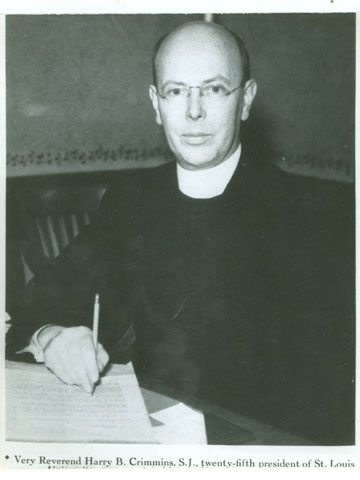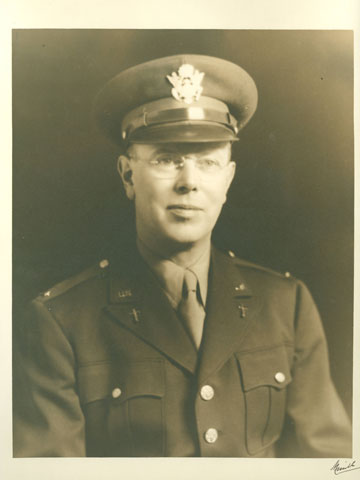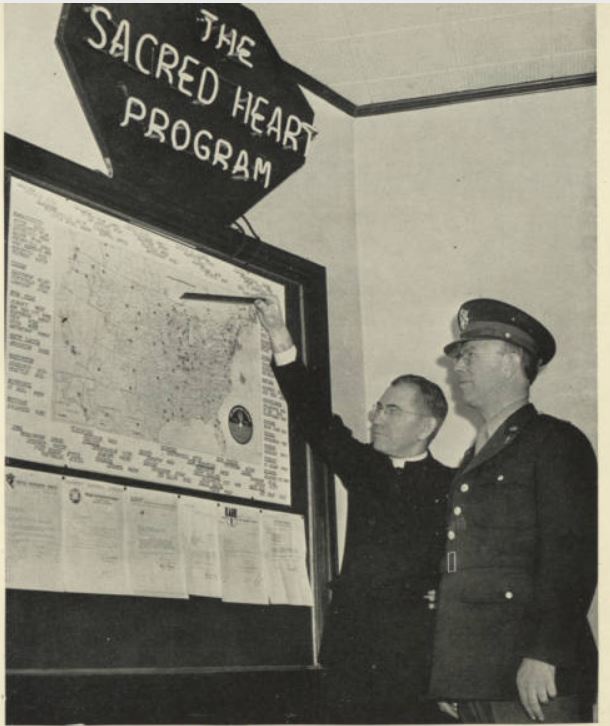SLU Legends and Lore: Harry Crimmins, S.J.
11/08/2019
While World War II ended for many of the 70th General Hospital Unit's doctors and nurses with the Allied victory over the Axis powers in 1945, former Saint Louis University President Harry Crimmins, S.J., the unit's chaplain, still had a mission to complete as the world grappled with the war's devastation and atrocities.
Known as Captain Harry B. Crimmins, Chaplain, United States Army, the St. Louis Jesuit resigned from his role as 25th president of SLU on Thanksgiving Day 1942, taking on the role of chaplain with the University-sponsored 70th General Hospital unit.
SLU sponsored and organized the medical unit at the request of federal officials as the United States entered World War II after the Japanese attack at Pearl Harbor in December 1941.

Crimmins stayed with the 70th for the duration of the war, ministering to its staff and patients in North Africa and Italy. SLU physician Sam Merenda, M.D. (Med '39), a member of the unit’s medical staff, wrote of Crimmins:
“Those of us who served with the Unit are forever grateful for having had this wonderful Jesuit as, not only our religious leader, but a great friend during the War. He was a great leader and source of inspiration to all of us.”
After the 70th was deactivated in October 1945, Crimmins remained in Europe, serving as a military chaplain.
As the Allies and the world grappled with the war's brutality and the many horrific acts committed during the conflict, the former SLU president's duties came to include serving as confessor and spiritual counselor for several German officers accused of perpetrating war crimes.
Who Was the President-Turned-Chaplain?
- Born in Keokuk, Iowa, in 1893, Crimmins entered the Jesuit novitiate at St. Stanislaus Seminary in Florissant, Missouri, in 1915.
- After receiving both his A. B. (1919) and A. M. (1920) degrees from SLU, he taught Latin, English, and algebra at Rockhurst College (now Rockhurst University) in Kansas City, Missouri, from 1920 to 1924, before returning to St. Louis to study theology.
- He was ordained a Catholic priest by Archbishop John Glennon in June 1926, going on to study philosophy at the Pontifical Gregorian University in Rome.
- Crimmins earned his doctorate in philosophy in 1932, and returned to SLU to teach philosophy.
- An essay in Better the Dream, a SLU history by William Barnaby, S.J., describes Crimmins as an "energetic man with an oval face, a bald head and a perpetual grin," writing, "He taught class or addressed an audience with the enthusiasm of a cheer leader at a homecoming rally."
- He was named University president in 1936.
- Called “The Beaming Billiken,” for his ever-present smile, Crimmins led SLU during the Great Depression, implementing stronger oversight of University finances.
- According to The Jewish Post, an Indiana newspaper, in October 1939, when anti-Semitic literature was offered for sale by two outside groups meeting on SLU's campus, Crimmins condemned the act of bigotry when the Jewish Coordinating Committee brought the incident to his attention. In a statement of condemnation, Crimmins wrote that the sale of the anti-Semitic books was "without qualification as indefensible and unworthy of an intelligent person."
- He resigned from his position as SLU president in 1942 to serve as the 70th General Hospital unit's chaplain.
A SLU Jesuit Lives Out Cura in Exceptional Circumstances

The officers Crimmins counseled included General Anton Dostler, commander of the 75th German Army Corps. Dostler had ordered the execution of 15 American soldiers who had been captured behind enemy lines in Italy in March 1944.
Dostler ordered the men's deaths despite the opposition of several low-ranking German officers who tried to dissuade him from executing the Americans, arguing the order violated the Geneva Convention.
Captured by the Allies in May 1945, Dostler was convicted of war crimes and sentenced to death by firing squad in Aversa, Italy. Crimmins went with Dostler to his execution, administering Last Rites and praying with the condemned general.
The 1945 Archive, SLU's yearbook, reported that as the war entered its final year, 7,121 sons of SLU were serving in the armed forces. One hundred twenty-four, including Crimmins, were acting as military chaplains. As of the Archive's publication that year, 142 SLU men had been killed in battle.
After the War
Crimmins left the Army in 1946. He returned to SLU to give a commencement address the same year.
He did not return to the University permanently, however. Crimmins traveled west, where he served first as a regent of Creighton University’s School of Medicine in Nebraska. He was stationed later at a church in Trinidad, Colorado.
Returning to St. Louis in 1953, he became pastor of St. Ferdinand parish in Florissant, and went on to serve as assistant pastor at St. Francis Xavier College Church briefly.
In 1957, Crimmins left St. Louis for Kansas City, where he returned to work as a chaplain at a local hospital. Later, he ministered at Rockhurst University until his death in 1960.
After 200 years, there are many legends and untold tales hiding in the nooks and crannies of Saint Louis University. Delve into the myths, fables, fantastic lives, moments and surprises you will find in its story with “SLU Legends and Lore.”
Story based on the "SLU Legends and Lore" Bicentennial Series by John Waide, University archivist emeritus. Photos courtesy of the Saint Louis University Archives and the National Archives and Records Administration (NARA). Story by Amelia Flood, University Marketing and Communications.
